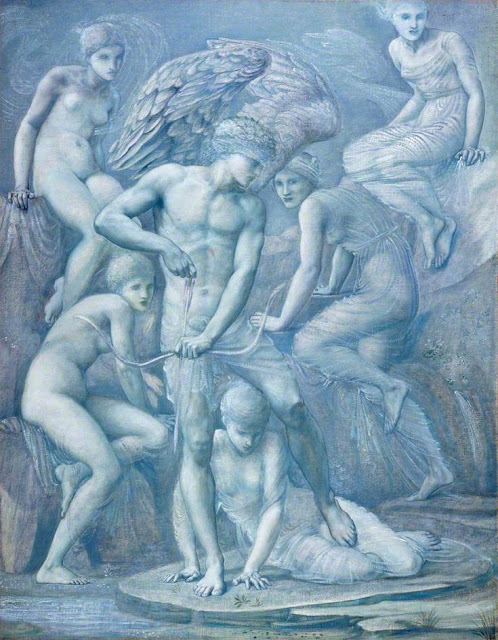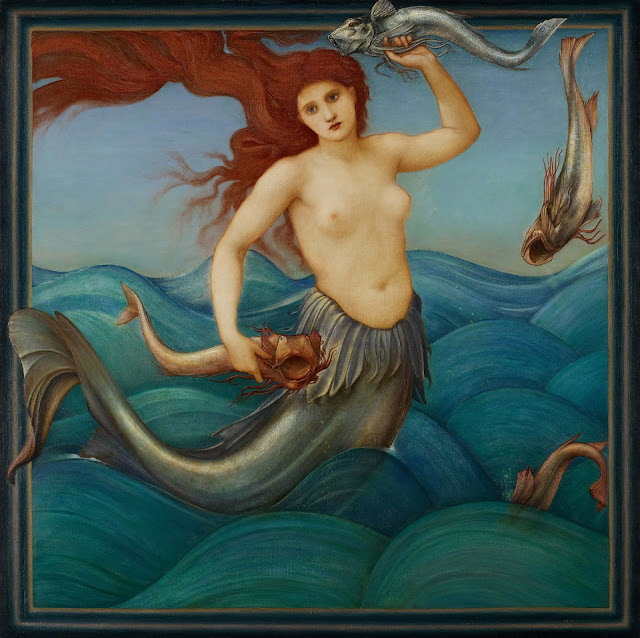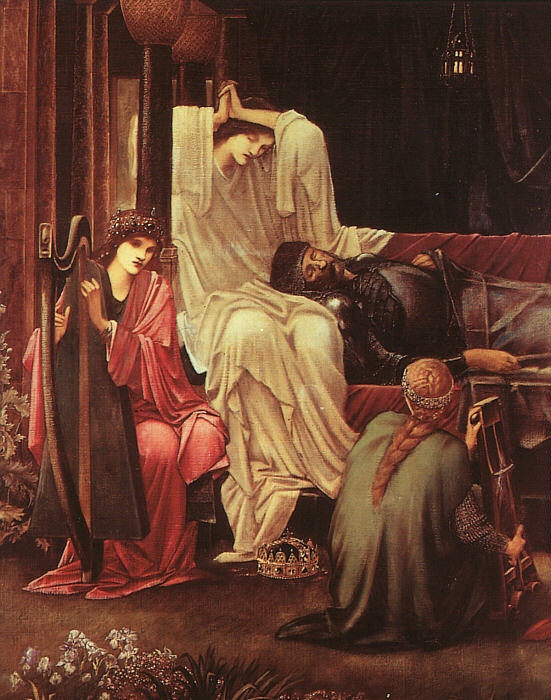
1898 Sir Edward Burne-Jones
by Sir Philip Burne-Jones, 2nd Bt
oil on canvas 76.2 x 52.2 cm
© National Portrait Gallery, London
Edward Burne-Jones became a founding member of William Morris’s decorative art firm in 1861, where he produced countless designs and illustrations for books, tapestries, ceramic tiles, mosaics and stained glass. In 1862, he travelled to Italy where he was introduced to Botticelli, whose formal patterning profoundly influenced his subsequent development as a painter. His typical subject matter derived from medieval and classical legends charged with symbolism. In fact, he was pre-eminent in the Aesthetic movement in England and the Symbolist movement in Europe. A defining characteristic of Burne-Jones as an artist was his wilful blurring of the boundaries between his painting and his decorative work.
For more information on Burne-Jones see part 1, and for earlier works see parts 1 - 11 also.
This is part 12 of a 14-part series on the works of Edward Burne-Jones:

c1880-90 Standing Female Nude
black chalk on paper 40 x 22.8 cm
Los Angeles County Museum of Art, CA
1880 Cupid's Hunting Fields
oil on canvas 99.1 x 77.5 cm
The Victoria and Albert Museum, London
1885 Cupid’s Hunting Fields
gouache, with watercolour and gold and silver paints on ivory wove paper, laid down on linen canvas 99.5 x 76.9 cm
Art Institute of Chicago, IL
c1880 Helen, a Mermaid
oil on canvas 29.5 x 71.5 cm
Tullie House Museum and Art Gallery, Carlisle, UK
c1880 Poesis textile (designed with William Morris)
wool and cotton 204 x 103.7 cm
National Gallery of Victoria, Melbourne, Australia
c1880 Stella Vespertina
oil on canvas 49 x 39 cm
William Morris Gallery, London
1880s Christ in Glory
stained glass made by Morris & Co.
Birmingham Cathedral 
1880s Love
watercolour on cloth 226.5 x 121.5 cm
Victoria & Albert Museum, London
1880s May Morris
oil on canvas 45.5 x 36 cm
Society of Antiquaries of London: Kelmscott Manor, Gloucestershire
1881 (published) Parable of the Boiling Pot
engraved by the Dalziel Brothers
wood engraving on paper 17.8 x 13.3 cm
Tate, London
n.d. Ezekiel and the Boiling Pot
ink and watercolour on vellum mounted on canvas
26 x 15.2 cm
Tate, London
1881 Lady Frances Balfour
oil on canvas 70 x 40 cm
Musée des Beaux-Arts de Nantes, France
1881 Pilgrim in the Garden from Chaucer's "Romance of the Rose"
black chalk over graphite pencil on two joined sheets of paper 91.1 x 116.5 cm
Museum of Fine Arts, Boston, MA
1881-82 The Tree of Forgiveness
oil on canvas 190.5 x 106.7 cm
National Museums Liverpool, UK
c1881-82 Study of Demophoön for ‘The Tree of Forgiveness’
graphite on paper 24.8 x 13.3 cm
Tate, London
1881-85 Wood Nymphs
oil on canvas 183 x 59.7 cm
Towneley Hall Art Gallery & Museum, Burnley, UK
1882 Atlas Turned to Stone
mixed media on paper 152.5 x 190 cm
Southampton City Art Gallery, UK
© 2018 Southampton City Art Gallery All rights reserved
1882 Earth Mother
encaustic on panel
Worcester Art Museum, UK
1882 Faith, Hope and Charity
stained glass made by Morris & Co.
St Mary's Parish Church, Dundee, UK
1882 Portrait of Katie Lewis
oil on canvas
Private Collection
1882 The Death of Medusa II
mixed media on paper 152.5 x 136.5 cm
Southampton City Art Gallery, UK
© 2018 Southampton City Art Gallery All rights reserved
1882 The Finding of Medusa
mixed media on paper 152.5 x 137.7 cm
Southampton City Art Gallery, UK
© 2018 Southampton City Art Gallery All rights reserved
1882 The Garden of the Hesperides
tempera and guilt on gesso panel 66 x 157 cm
Victoria & Albert Museum, London
1882 The Garden of the Hesperides detail 
1882 The Garden of the Hesperides detail 
1882 The Hours
oil on canvas 118.7 x 227.8 cm
Graves Art Gallery, Sheffield, UK
1882 The Mermaid
gouache and watercolour on paper 31.2 x 23.5 cm
Tate, London
1880s Sketchbook 27.6 x 16.9 cm
Victoria & Albert Museum, London:
1881 Nymphs:

1881 A Sea-Nymph
oil on canvas
Minneapolis Institute of Arts, Minnesota
c1881 Sea Nymph
design for sculptural relief bodycolour on brown paper
62.6 x 62.6 cm
c1881 Wood Nymph
design for sculptural relief bodycolour on brown paper
62.6 x 62.6 cm
c1881 Wood Nymph
pencil, watercolour and bodycolour heightened with gold and touches of gum arabic on paper 36.5 x 39.7 cm
c1881 Wood Nymph
photogravure on paper
Birmingham Museum and Art Gallery, UK
1881-96 The Last Sleep of Arthur in Avalon:
when Burne-Jones’s daughter, Margaret McKail, died in 1953, sheaves of his drawings were put up for auction by the executors of her estate but sold for next to nothing. Ten years after that, Burne-Jones’s largest and most ambitious picture, The Sleep of Arthur in Avalon – the magnum opus on which he had worked for eighteen years, until the day of his death – was quietly sold abroad. There were no protests, no petitions. Christie’s, which had estimated the work at between £2,000 and £5,000, knocked it down for a mere 1,600 guineas to the dealer Peter Nicholson, who was acting as agent for Luis Antonio Ferre, a Puerto Rican engineer and industrialist. Ferre, a who later served as third Governor of the Commonwealth of Puerto Rico, was building an art collection for a new museum on the island; and in 1965, Burne-Jones’s enormous painting was duly installed in a custom-built gallery in the Museo de Arte de Ponce.

1881-98 The Last Sleep of Arthur in Avalon
279 x 650 cm
Museo de Arte de Ponce, Puerto Rico
The Last Sleep of Arthur in Avalon detail 
The Last Sleep of Arthur in Avalon detail 
c1881 Study for figure placement in “The Last Sleep of Arthur at Avalon”
graphite, watercolour and bodycolour on a prepared ground 41.9 x 57.4 cm
Carnegie Museum of Art, Pittsburgh, PA
c1881 Study of Architecture for “The Last Sleep of Arthur at Avalon”
graphite, watercolour and bodycolor on a prepared ground 41.9 x 57.4 cm
Carnegie Museum of Art, Pittsburgh, PA.
1896 A Study of Olive Maxse for one of the mourning Queens in 'The Sleep of King Arthur in Avalon'
graphite on paper 33 x 23.2 cm
Study of a draped female figure for 'The Sleep of Arthur in Avalon'
black, white and sanguine chalk on terracotta paper 45 x 27.3 cm









No comments:
Post a Comment
Note: only a member of this blog may post a comment.